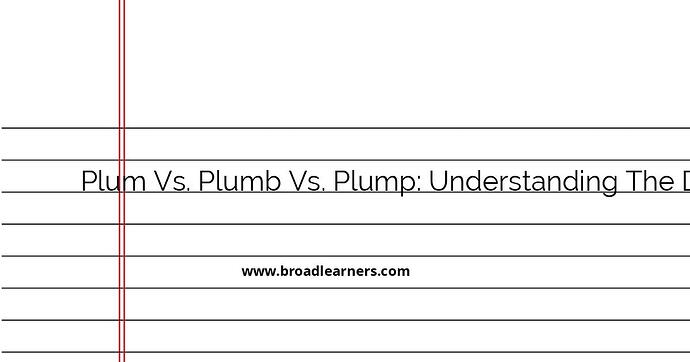English is a language rich with homophones and near-homophones, where words sound similar but have different meanings. A commonly confused set of words are "plum," "plumb," and "plump." Understanding these differences is essential for both writing and speaking accurately. Below is a detailed explanation of each term, along with examples to illustrate their proper usage.
- Plum
-
"Plum" is a noun that refers to a type of fruit, a drupe from the genus Prunus. It is characterized by its sweet and juicy interior and smooth skin. In broader contexts, "plum" can also figuratively describe something highly desirable.
Examples:
I bought a basket of plums at the farmer's market, and they were deliciously sweet.
The job offer was a plum position, complete with an excellent salary and benefits.
- Plumb
-
"Plumb" can be used as a verb, adverb, noun, or adjective. As a verb, it means to measure the depth of something, typically water. As an adjective or adverb, it describes being completely or precisely vertical or straight. As a noun, it refers to a tool used for vertical alignment.
Examples:
The carpenter used a plumb line to ensure the wall was perfectly vertical.
She found herself unable to plumb the depths of his thoughts and emotions.
- Plump
-
"Plump" is primarily an adjective that describes something as round, full, well-filled, or slightly fat in an attractive way. It is also used as a verb meaning to make something rounder or fuller. It can sometimes be utilized to imply generosity or abundance.
Examples:
The kittens were well-fed and plump, showcasing their health and care.
She decided to plump the pillows before leaving the guest room to ensure comfort.
Here is a brief summary of the key differences:
- Plum: A type of fruit; figuratively, something desirable.
- Plumb: To measure depth; perfectly vertical; sincere intentions.
- Plump: Rounded in shape; to make fuller.
By recognizing these distinctions, your understanding and use of each term will be more accurate, enhancing both written and spoken clarity.
Did I miss anything? Respond below
